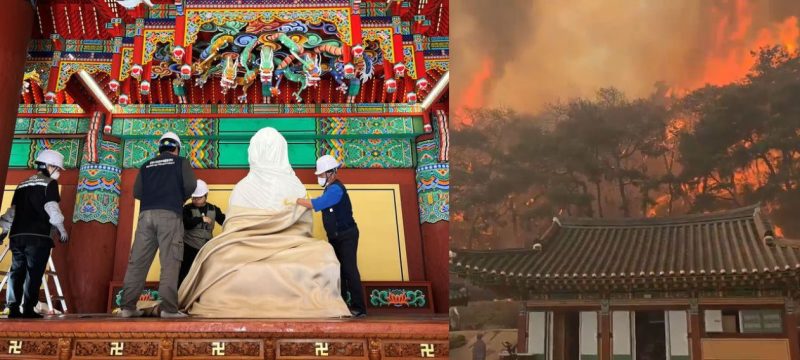The once vibrant and colorful Gounsa temple in South Korea now stands in ruins, charred and blackened by a devastating wildfire. Known for its historical significance, the temple, originally built in 681 by Buddhist monks, suffered extensive destruction this week as South Korea battled its largest wildfire in history. The blaze ravaged forests and towns, claiming at least 26 lives and damaging several priceless cultural landmarks.
“The wind was stronger than a typhoon, and flames swirled like a tornado, consuming everything in an instant,” said Gounsa’s chief monk, Deungwoon, in an interview with Reuters. “More than 1,300 years of Buddhist heritage and history have been completely wiped out.”
Read more: Japan Battles Largest Wildfire in Over Three Decades, Forcing Thousands to Evacuate
Among the wreckage, a massive bronze bell lay shattered, its surface deeply cracked. Two of the three national treasures housed at the temple were reduced to ashes, while a few structures miraculously survived. The Korea Heritage Service reported that at least 18 designated heritage sites and objects, including national treasures, had suffered damage or total destruction.
In response, authorities deployed around 750 personnel to protect historical sites, implementing emergency measures such as spraying fire retardants, wrapping structures in fire-resistant cloth, creating firebreaks, and evacuating valuable artifacts, including Buddha statues. More than 1,500 relics were transferred from major temples like Gounsa and historical family estates.
Hahoe Folk Village, a UNESCO World Heritage Site, faced an imminent threat from the advancing fire. Officials took precautionary measures, including spraying fire retardants and reinforcing its thatched-roof houses, while urging residents to evacuate. As of Thursday, the village remained intact.
Throughout Korean history, fire has been a constant threat to traditional wooden structures. Many temple halls, including those at Gounsa, had bronze bowls of water placed outside as a symbolic reminder of the fire hazard. Though parts of Gounsa have been damaged by fires before—most recently in 1975, before undergoing restoration in 1992—the scale of this devastation left many in shock.
Seventy-year-old Kim Young-hoo, a devoted follower, expressed his grief: “The pain is beyond words. Seeing this sacred place destroyed so completely is heartbreaking.”
Opposition leader Lee Jae-myung visited the smoldering ruins and called for enhanced protection of other at-risk heritage sites. “I have been informed that several other historic temples are in imminent danger,” he stated.









